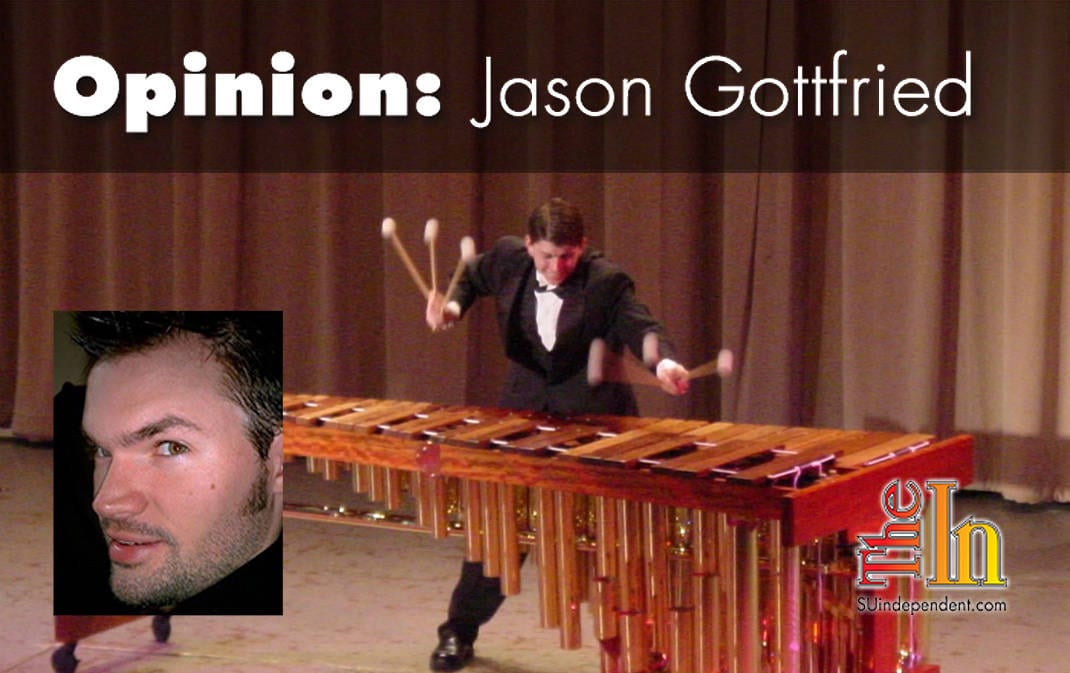 Earlier this month, the Heartland Marimba Festival was hosted at Southern Utah University. Michael Burritt, my own teacher’s college roommate, was there. So naturally, I was excited to see him play since it had been about 15 years since I had. Burritt is a bit of a celebrity — like the Yo-Yo Ma of the marimba. And as always, he was brilliant.
Earlier this month, the Heartland Marimba Festival was hosted at Southern Utah University. Michael Burritt, my own teacher’s college roommate, was there. So naturally, I was excited to see him play since it had been about 15 years since I had. Burritt is a bit of a celebrity — like the Yo-Yo Ma of the marimba. And as always, he was brilliant.
During a recital Friday, he briefly mentioned how percussion is the new violin. He was referring to a 2009 article in the New York Times wherein Alan Kozinn wrote, “If you think about it, drums are the new violins.”
Burritt’s (and Kozinn’s) point was that composers are writing for percussion now at a rate similar to that at which they used to write for other instruments, like the piano and violin.
It’s true. It’s great news for a percussionist … but I’m not sure it’s a good thing for music overall, and it’s one reason why I stopped my formal studies in percussion performance after my undergraduate degree: I hate shitty music.
(As a quick side note, I did study music performance with an emphasis in percussion and composition in my undergraduate. The selections performed at the Friday recital I attended exhibited a good balance of traditional and nontraditional harmony, and while Burrit’s own compositional style does usually depart from traditional harmony, he rarely totally abandons tonality. For the record, I’m a fan.)
Anyway, ever since Arnold Schoenberg blew the ass out of the German Expressionist movement with his “emancipation of dissonance,” it’s been cool to be weird. Hey, I support that. I’ve written my fair share of 12-tone, serial, and other harmonically adventurous material. But I’m not playing Toshimitsu Tanaka’s “Two Movements for Marimba” on the street corner, because while it’s fun to play (especially when you play it really fast!), no one wants to hear it.
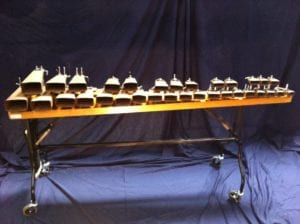
Percussion has been an emerging family of instruments in the classical world, increasingly so over the past century in particular. Therefore, composers who are desperate for their music to be played will write for percussion. They know it will be played, because unlike other instrumentalists, percussionists don’t have centuries of repertoire handcrafted for them by the most brilliant minds Western Civilization has produced. In other words, beggars can’t be choosers.
Since tonality has already been done, and since writing great music is hard, it’s always easier — and now not only fashionable as well but seemingly expected — for young composers in the ivory tower to write harmonically avant-garde music. Otherwise, they end up writing mediocre tonal music.
The result is that most marimba literature, like the bulk of the percussion repertoire, is wholly unapproachable by the average listener. With some truly magnificent exceptions, it is largely unlistenable for most. Outside the microculture of the academic percussion world, no one wants to hear it. And if percussion is the new violin, screaming is the new singing.
The marimba now has a standardized range that is the same as a cello’s. Cello music is lush and gorgeous on a marimba, and I think that J.S. Bach’s cello sonatas sound even better on a marimba than on a cello. The problem is that few percussionists have the balls to perform tonal music like that of Bach on the marimba. Think about it: a pianist, a guitarist, or a violinist can all touch their instruments — one of the many reasons I love playing guitar so much. You can play the guitar in the dark, but try playing the marimba with the lights off. (Just not with me around to hear it.)
Therefore, developing kinesthetic memory, which is essential to accuracy in performance, is a Herculean task for the marimbist. Translation: The marimba is an instrument that was custom-made for accidentally playing wrong notes. That makes marimbists scared to play tonal music, like that of Bach wherein it would be obvious to the layperson if they are screwing up. They hesitate to play music that people understand because people would be able to hear it when they mess up. As such, Bach transcriptions and other tonal percussion music are seemingly reserved for bolder musicians whereas the steaming pile of musical gibberish that is contemporary marimba music, which is largely unintelligible and therefore safer, is better suited for lesser players.
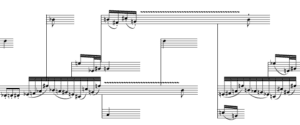
Do you see where I’m going with this?
Tell me, What is more likely on your iPod: Coldplay or Karel Husa? Stevie Wonder or Stockhausen? The Piano Guys or Pendereski? Click those links and have a taste. Get up and dance, y’all. While it’s fascinating from a compositional standpoint, no one wants to hear this nonsense. Blame the composers or blame society, but it’s true.
To illustrate my point, I’ve always wanted to do an experiment wherein I play a recital and just make up names for pieces and invent imaginary composers to have written them. I walk out on stage, bow, and bang around dramatically for ten minutes, gesturing meaningfully and stomping and flapping around with four mallets like a schizophrenic deaf mute. Emotionally spent, I bow, you clap, and I walk off stage. You don’t know the difference, because that’s exactly what most contemporary marimba music sounds like to the average listener.
If music isn’t emotionally engaging, I’m not particularly interested in it. If the common man can’t relate to it, I don’t think it has much value to society. Almost no one wants to listen to contemporary music, yet it almost entirely comprises the percussion repertoire.
So if percussion is the new violin, my vibraphone gently weeps.




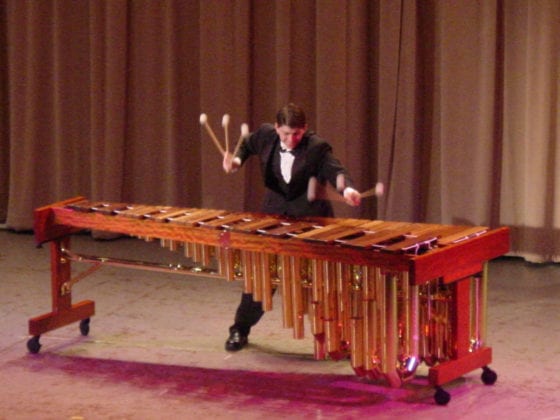
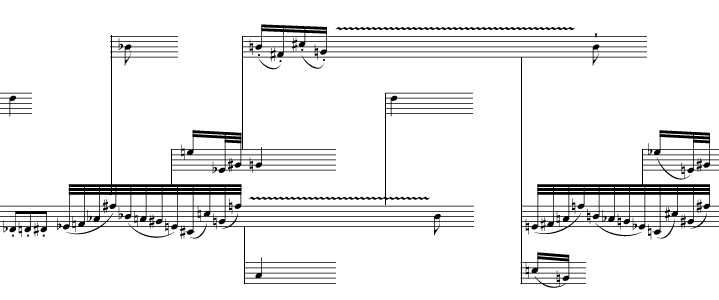
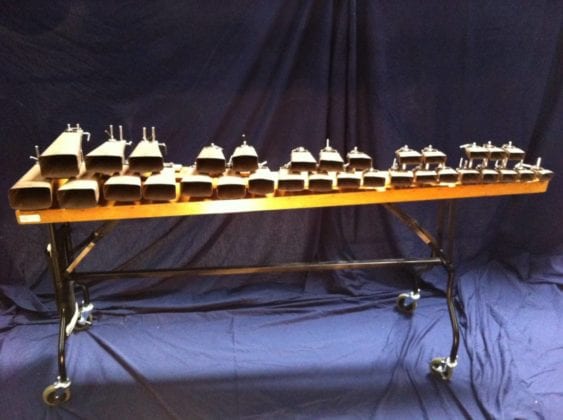



SEE Michael Giles, 1967, Original drummer King Crimson, Christian Vander of MAGMA, Bill Buford of YES/Genesis/King Crimson & others, Carl Palmer of ELP, and last but not least, Ginger Baker of Cream. The shift began in the mid 60s… rock = Progressive Rock and then jazz fusion. Otherwise it was advante garde prior to that.
Bruford… sorry, as Monty Python would phrase it. I have to be honest, you’re article was almost too much for my brain. Not sure how many people would get beyond the fifth paragraph. I guess it is a unique niche topic, and somebody needs to pursue it. I would argue Ableton and other Midi based software and corresponding controllers are the new violin . But then again I am just a fool. However a fan as well.
Is this a joke?
No. You have confused a joke with a different, non-joke thing. To assist you with your confusion between jokes and other things that aren’t jokes, here is a joke for comparison.
“I once had a dog with no nose.”
“How did he smell?”
“Terrible.”